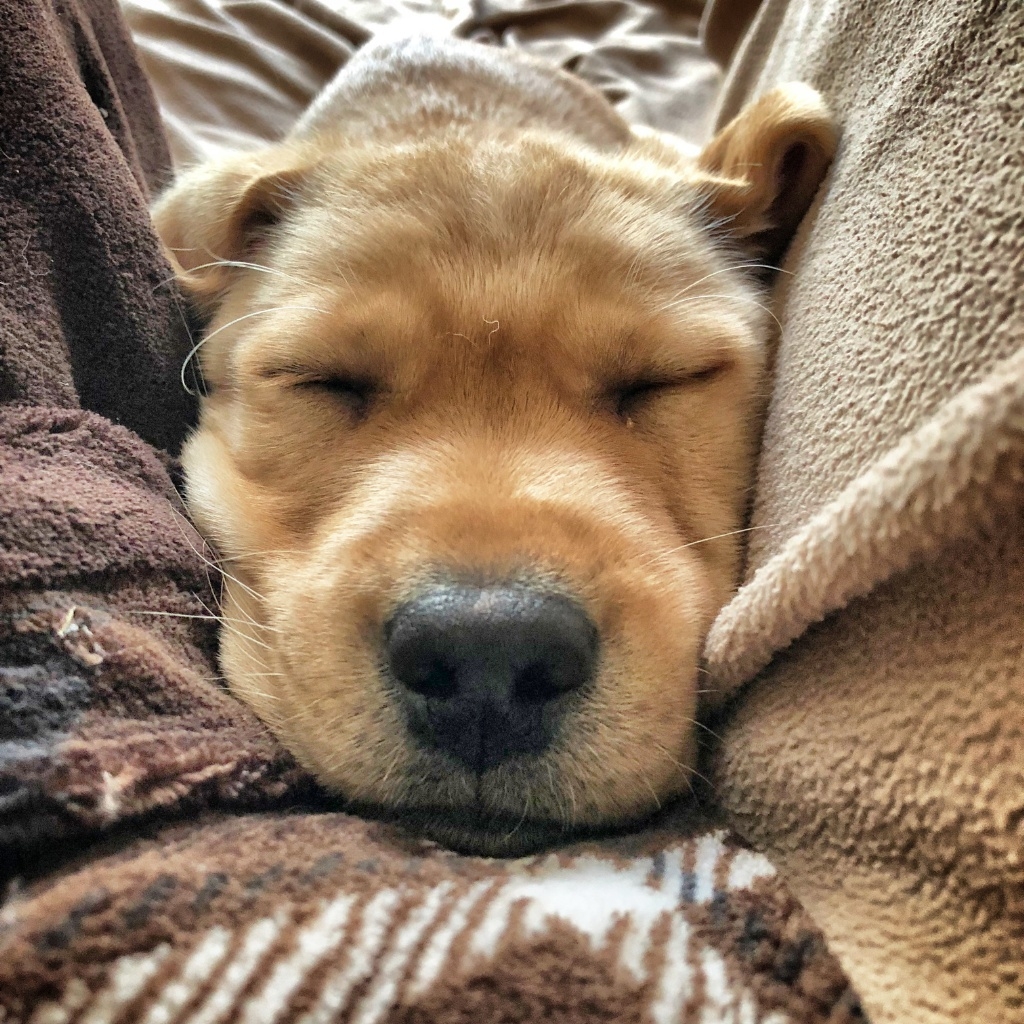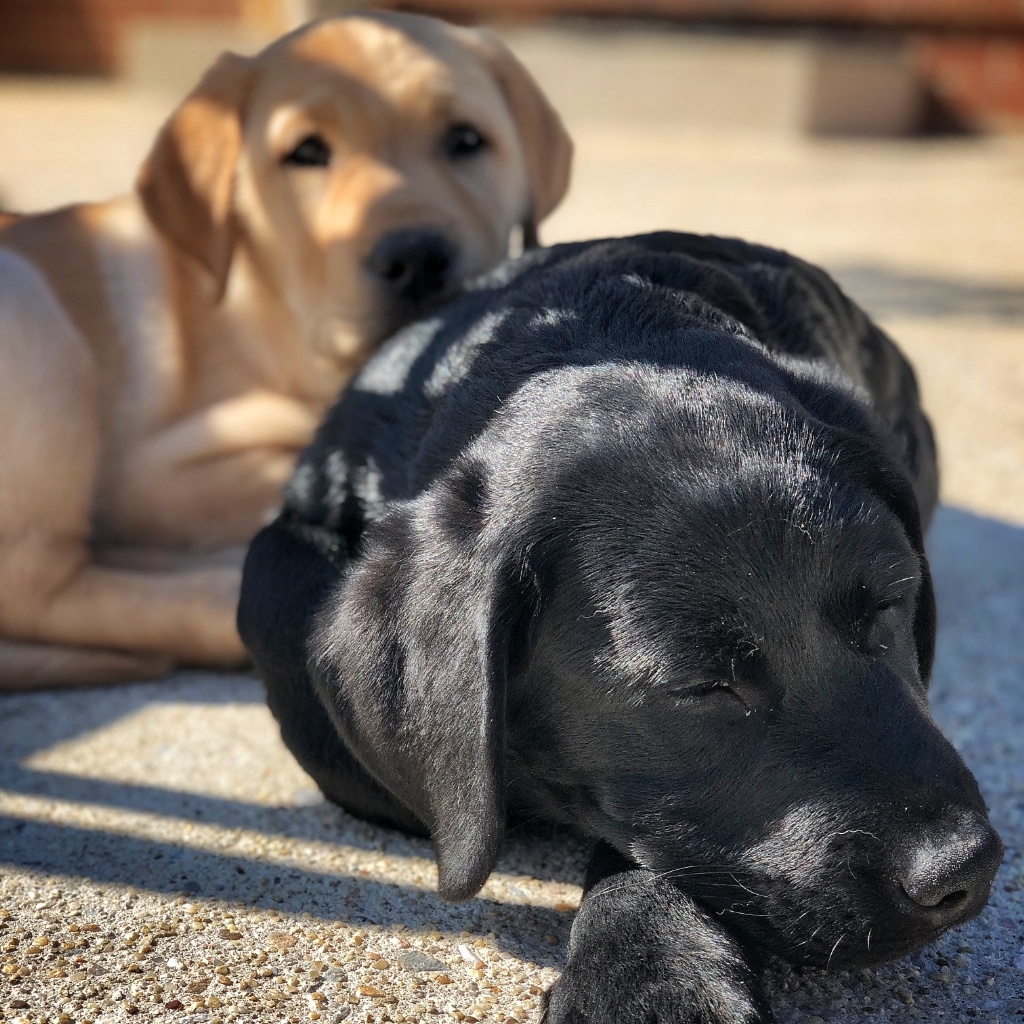Introducing Service Puppy in-Training, Rogan
Welcome, Rogan!
We’re back in the world of raising service puppies again! I promised our seniors (Nemo, Lily, and Tango — service dog dropouts themselves) that as they entered their “golden years,” they could retire from helping us raise service puppies. Levi was the last service dog we raised. We picked him up in January 2014 — four years ago since a service puppy in-training was in our house!

Sadly, we lost all four of our dogs over about a year and we found ourselves with an empty house. We brought on sweet Walter, a pup I’m raising for a client. And then, given the news of our (almost) empty house, a service dog organization asked us if we could raise a pup for them again. Adventurous is how you might describe us, and we said “Of course!”
There were eight puppies in Rogan’s litter. I wasn’t sure whether our pup would be a yellow or a black. I was ambivalent — I just lost the love of my life yellow Labrador, Tango. I was torn between really wanting another yellow in the house and being terrified that a yellow would come live with us. Obviously, Rogan is a yellow. It took a few days for me to adjust to another yellow in the house. He’s very different (of course) than Tango was which makes his presence in our house a lot easier for me and my heart.

Needless to say, Walter is thrilled to have a young playmate. And we love having two dogs in the house together. While I don’t love the idea of litter mates, Walter and Rogan are seven weeks apart which means less risk of co-dependence and the other problems that come along with litter mates. We are, of course, also working hard to ensure that these puppies learn how to be independent and enjoy frequent people-time, as well. They are great playmates and entertainment for one another. These two tire one another out in a way that we never could.


Rogan’s training
Rogan’s training has already begun. Puppies are capable of learning so much that we start right away at eight weeks. These pups actually started their learning prior to going to their puppy raiser homes. They all learned to sit for whatever they wanted from any human. How, you ask, do you teach a litter of eight puppies to sit?! Simple: wait for it to happen, then reinforce it when it happens. What does this look like in real life? When it’s feeding time (or visiting time), the puppies get a morsel of food as soon as their rump hits the floor. They learn fast: all that stands between them and a piece of food (or some human affection and attention) is to put their rump on the floor! And it’s a whole lot easier to sit than it is to jump!

It’s important for any dog, but particularly a service dog, to learn that behavior has consequences. One of Rogan’s first training lessons was an “attention” session. I used part of his breakfast to teach Rogan that looking at me earned him a small part of his breakfast. I sat on the floor, clicker in hand, and simply waited for Rogan to look in my direction. The instant he did, I clicked and reached to give him a piece of his breakfast. The click tells him exactly what he’s doing to earn the goodie. I do a little bit of this everyday and it’s amazing how quickly Rogan voluntarily looks at me — not just in a training session, but whenever he’s not sure what to do.
There will be many lessons coming up for Rogan. Stay tuned, I’ll post updates and adventures here!

 My parents got a mixed breed dog from the local shelter almost a year ago.
My parents got a mixed breed dog from the local shelter almost a year ago. DNA My Dog is based in Canada and has 94 breeds in it’s genetic database. In addition to DNA tests for living dogs, they also offer DNA testing for deceased dogs. The sample collection for a deceased dog is dependent on the availability of a clean saliva sample, say from a doggie toothbrush. The test for a deceased dog is more expensive, as the company needs to collect the DNA from the toothbrush or slobber-laden toy.
DNA My Dog is based in Canada and has 94 breeds in it’s genetic database. In addition to DNA tests for living dogs, they also offer DNA testing for deceased dogs. The sample collection for a deceased dog is dependent on the availability of a clean saliva sample, say from a doggie toothbrush. The test for a deceased dog is more expensive, as the company needs to collect the DNA from the toothbrush or slobber-laden toy.

 I’ve had “write blog post” on my daily schedule for the last six days. I keep moving it.
I’ve had “write blog post” on my daily schedule for the last six days. I keep moving it. It started when our 11-year old “healthy” dog, Nemo,
It started when our 11-year old “healthy” dog, Nemo,  We’d been dealing with canine cognitive dysfunction for over a year and with, I think
We’d been dealing with canine cognitive dysfunction for over a year and with, I think 

 In hindsight, I think he’d been having the problem since at least June, but I chalked it up to heat intolerance, not heart trouble. But when Schoons’ lethargy expanded to his daily routine — not just our runs — I got worried.
In hindsight, I think he’d been having the problem since at least June, but I chalked it up to heat intolerance, not heart trouble. But when Schoons’ lethargy expanded to his daily routine — not just our runs — I got worried. Anyway, I digress. Schooner is now not allowed (nor is he capable) of running with me.
Anyway, I digress. Schooner is now not allowed (nor is he capable) of running with me.
 We don’t have a prognosis for Schooner, but the (many) medications he’s on have helped considerably. He’s playing again — throwing around toys, more energetic, looks like he’s feeling peppy again. So, while this is not what I’d hoped for, it’s certainly better to know about it and help him live longer and happier. We will have regular check-ins with our veterinarians and with the cardiologist. Hopefully, we’ll have a prognosis in about three months after the cardiologist evaluates Schooner’s improvement with medication.
We don’t have a prognosis for Schooner, but the (many) medications he’s on have helped considerably. He’s playing again — throwing around toys, more energetic, looks like he’s feeling peppy again. So, while this is not what I’d hoped for, it’s certainly better to know about it and help him live longer and happier. We will have regular check-ins with our veterinarians and with the cardiologist. Hopefully, we’ll have a prognosis in about three months after the cardiologist evaluates Schooner’s improvement with medication. When we take the dog for a walk (you know, just a normal dog walk) around the neighborhood, we mainly want to relax and get a little exercise and enrichment for ourselves and our pups. So functionally, we need a behavior that keeps the dog within a 6ft radius of us as we go along, and keeps the dog from tripping us as we walk.
When we take the dog for a walk (you know, just a normal dog walk) around the neighborhood, we mainly want to relax and get a little exercise and enrichment for ourselves and our pups. So functionally, we need a behavior that keeps the dog within a 6ft radius of us as we go along, and keeps the dog from tripping us as we walk. Heeling is a lot more “expensive” for the dog because he has to really focus tightly on the handler to maintain a precise position and change direction and speed almost simultaneously. With heeling, we want the dog to stay within a SINGLE INCH of the same position relative to the handler. So if the dog’s collar is level with the handler’s kneecap, that collar should never drift more than an inch ahead or behind, or closer or further away. It should be as if there is an invisible, 1-inch long bungee cord, tethering the dog to the handler at all times.
Heeling is a lot more “expensive” for the dog because he has to really focus tightly on the handler to maintain a precise position and change direction and speed almost simultaneously. With heeling, we want the dog to stay within a SINGLE INCH of the same position relative to the handler. So if the dog’s collar is level with the handler’s kneecap, that collar should never drift more than an inch ahead or behind, or closer or further away. It should be as if there is an invisible, 1-inch long bungee cord, tethering the dog to the handler at all times.

